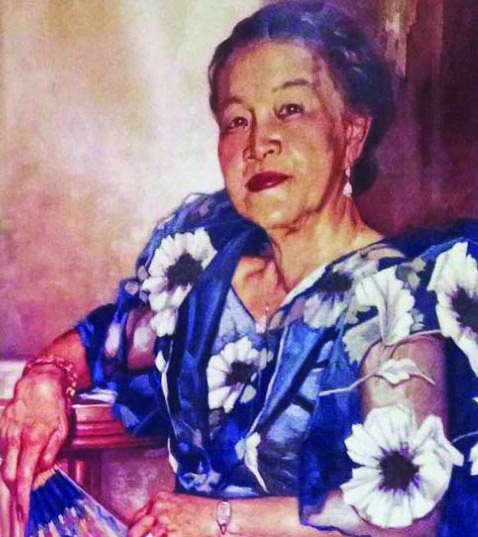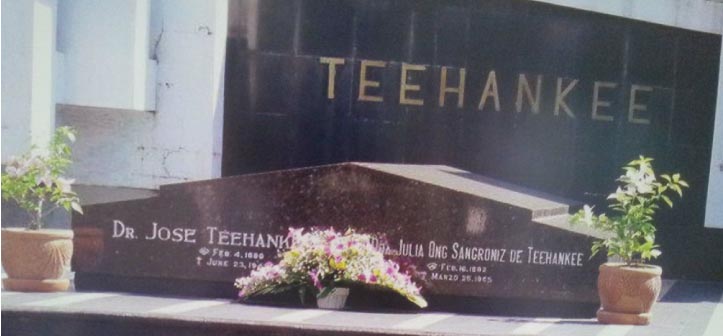The Teehankee family gathered at Kaisa-Angelo King Heritage Center in Intramuros, Manila on June 23, 2013 to commemorate the 70 death anniversary of their patriarch, Dr. Tee Han Kee (鄭漢淇 1879-1943). Tee was the first Chinese doctor to be appointed in government service. As public health officer, he was assigned to attend especially to the issues of health, sanitation and hygiene in the Chinese community, a position he would carry for 20 years.

Tee’s family was originally from Xiamen, Fujian. Tee himself was born in Manila in 1879 but was sent to China for his education. Upon obtaining a medical degree in 1902 from the Hong Kong Medical College, Tee returned to the Philippines and took the medical board examinations, passed it and allowed to practice in these islands. He was first appointed assistant surgeon in the Philippine Health Service.
Tee was the first director of the Chinese General Hospital during the hospital’s inauguration in 1921. In the same year, he also founded the Chinese General Hospital School of Nursing.

Tee Han Kee, with the help of three other physicians, set up the training school and requested the Sisters of the Immaculate Concepcion in Hong Kong and Canton through the Archbishop of Manila to assist in the early stages of the operation of both the hospital and the school of nursing. The sisters, understanding the great need, readily agreed to render service, impressed as they were with Tee and his team. The hospital served mainly the Chinese community which at that time was close to 40,000 in number.
In the same medical school in Hong Kong, Tee was classmate to Dr. Sun Yat Sen, Chinese revolutionary, political leader, foremost pioneer of Nationalist China, and referred to as the Founding Father of Republican China. They served together as doctors at the St. Elizabeth Hospital in Hong Kong.

As such, he greatly supported Dr. Sun’s aspiration for China to be emancipated from the shackles of misrule and oppression of the Imperial Qing Dynasty. He followed closely the course of Sun Yat Sen’s revolution. He established the Pu Zhi Shu Bao She to promote revolutionary causes and served as the head of the organization for 21 years.
In 1911, Tee helped establish the Tongmenghui branch in Manila and in October of the same year, he co-founded the Kong Li Po as official organ of the revolution.

He served as the managing editor of the newspaper, helped in the translation of news and through the paper, he helped organize fund-raising activities to support the revolution. Subsequently, he was elected president of the Philippine Branch of the Kuomintang (Chinese Nationalist Party).
Tee is known for his expertise in preventing bubonic plagues and cholera epidemics. In the early 1900s, when there was barely any hygienic practices to speak of, Tee enforced strict sanitation rules like burning all the belongings of patients who died of infectious disease and disinfecting the households where these patients stayed.

With this expertise, he was appointed as medical supervisor of the Infectious Diseases Department of the Chinese General Hospital and served as a consultant in infectious diseases for the Philippine Health Service.
His service to the community did not stop with medical expertise. Tee Han Kee was a co-founder of the Manila Chinese Chamber of Commerce in 1904. He was the first president of the Filipino-Chinese Medical Society and the chairman of the Chinese General Hospital.
Aside from the Chamber of Commerce, Tee was a director of the Chinese Charitable Association and the Huaqiao Educational Association. He also established the Chinese Protestant Youth Association.

Beyond the call of medical service, Tee was appointed as vice chairman of the Japanese-sponsored Chinese Association, tasked to administer the affairs of the Chinese community and to raise funds from them in support of the Japanese. Thus, he was branded as a collaborator and in 1943, he was assassinated by anti-Japanese guerrillas.
It was only after the war, during the war crimes trial, that it was proven that Tee, instead of being a collaborator, in fact secretly supported the war efforts against the Japanese. His clinic had a hidden chamber where he would secretly treat guerrillas and other casualties of Japanese atrocities. His clinic also served as a front to distribute propaganda materials.
Most notable among Tee’s children is the late Chief Justice Claudio M. Teehankee
(鄭建祥) known as the “dissenting activist justice” due to his opposition to policies that curtailed people’s liberties. Teehankee was called the “conscience of the Supreme Court.”

Upon the conferment of Honorary Doctorate of Humane Letters in 1986 by Ateneo de Manila University, the citation reveals that in the darkest days of Martial Law, Teehankee “defied the tyranny of numbers and cast doubt on the validity of his regime, question the justness of its cause, and belie its adherence to the rule of law.
Consistently, Teehankee’s dissenting opinions valiantly stripped away the curtains of legality that Marcos draped over his regime… The days of the Marcos regime may have been the darkest in Philippine history. They were also days when Teehankee’s courage shone the brightest.”
Teehankee’s steadfast dedication to truth and justice and clarity of vision restored people’s faith in the justice system, especially in the area of human rights.

In his capacity as acting Chief Justice, he swore in Corazon Cojuangco Aquino as President of the Philippines, at Club Filipino, San Juan at 10 a.m. in 1986, two hours before Ferdinand Marcos’ similar oath-taking at Malacañang on Feb. 25 at noon.
In recognition of his integrity and dedication to service and for being the sole consistent force against the government of Marcos, Claudio Teehankee was subsequently named Chief Justice by President Aquino in April 1986. (Excerpted from Suryadinata, Leo ed. (2012) Dictionary of Southeast Asians of Chinese Descent. Singapore: ISEAS. Copies are available for sale at the Chinben See Memorial Library. Email [email protected] for inquiries.) — First published in Tulay Fortnightly, Chinese-Filipino Digest 26, no. 3 (July 9-22, 2013): 16, 12.
